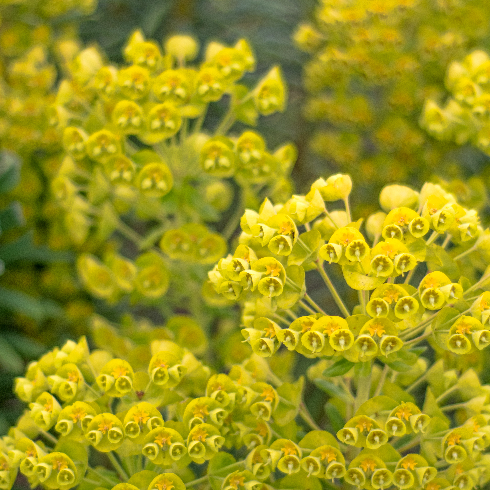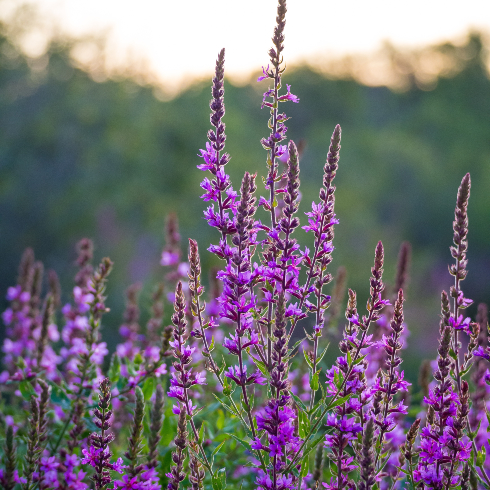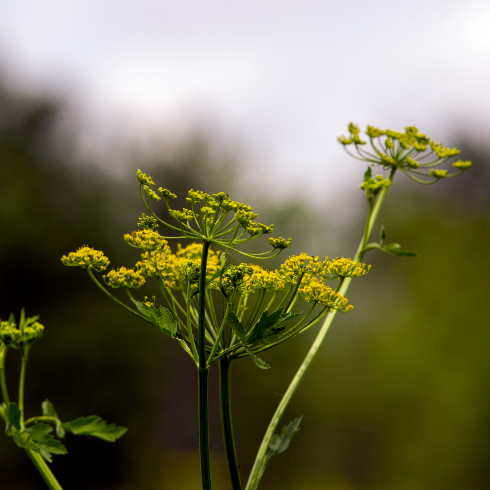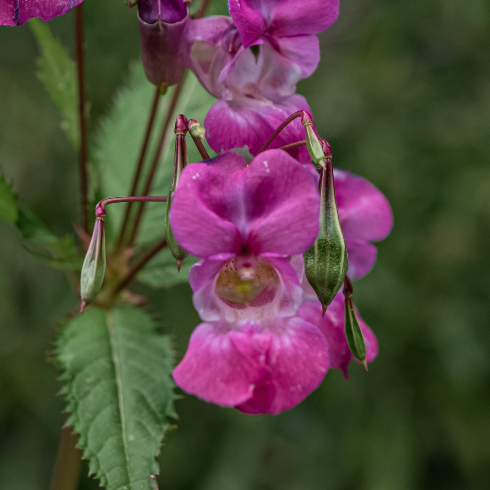Invasive plant species are non-native plants that were brought to Canada and have since become problematic, reducing the biodiversity and creating harm to the local environment. These 10 invasive plant species are known to grow fast and stifle out competing vegetation, making them a threat throughout the country. Invasive species are often not a food source to either humans or local wildlife — instead, they can often be poisonous or harmful. Here are ten invasive plants that you’ll find from British Columbia to Ontario and beyond to watch for, plus the best method of removal.

Wild Caraway
Wild caraway (Carum carvi) is an edible spice plant that was introduced to Canada from Europe and Asia. It can be identified by its white flowers when in bloom. Wild caraway is considered invasive for its potential to outgrow and overtake native Canadian plants. It’s also a hearty plant that can grow in a number of less-than-ideal conditions, including light flooding and droughts. The most effective means to contain wild caraway from spreading is to hand pull before it seeds, as they spread easily.

Leafy Spurge
Leafy spurge (Euphorbia esula) came to Canada from Europe, and can now be found in nearly every province. This tall, yellow flowering plant can tower over other native plants at one metre high, and tends to hog both sunlight and water. It can also spread its many seeds quite far, and it releases toxins to prevent other plants from growing. If that weren’t enough, the plant is known to release a milky liquid, which is an irritant to human skin. This invasive plant species has taken over 140K hectares in Manitoba alone! The best way to remove this invasive plant is through a combination of herbicides and planting competitive grasses to contain its growth.

Purple Loosestrife
Though beautiful to look at, purple loosestrife (Lythrum salicaria) is considered invasive. Brought from Europe, it can now be found in nearly every Canadian province and territory and US state. With its ability to produce up to two million seeds, its no wonder this plant has spread like wildfire across the continent, displacing other plants that are important for providing food to the native ecosystem. The summer months, prior to flowering, are the best time to remove this plant, cutting it at the stalk.

Japanese Knotweed
Japanese knotweed (Reynoutria japonica) is one of the most persistent plants in the invasive knotweed family. It was originally brought to North America from Asia to feed livestock and as an ornamental plant, but today, it’s illegal to grow or sell in Ontario. The plant grows quickly and can cause severe problems for property owners, making it one of the most disdained invasive plants. What’s more, it’s hard to get rid of — often requiring many rounds of application of a glyphosate-based weedkiller.
You Might Also Like: The Easiest Vegetables to Grow in Each Canadian Province

Common Reed
Phragmites, or common reed, is a familiar site in Canada, especially in wetland areas. But it’s actually an invasive species of grass that’s pushing out other grasses and decreasing the biodiversity. In fact, some consider it the most invasive plant to Canada. Originally native to Europe and Asia, this plant spreads quickly due to its ability to spread seeds in the wind. Not only does it threaten other plants; its dense roots make it difficult to remove, and difficult for wetland animals like turtles and snakes to navigate through. The most effective means of removal is through foliar-applied herbicides.

Garlic Mustard
Garlic mustard (Alliaria petiolata) is of particular concern in Ontario. Not only does it pose a risk to the province’s official flower, the trillium, but it can also change the soil chemistry and growth of fungi once established in an area. In doing so, it can threaten the local environment and other native plants. The herb, brought from Europe, can be identified by its strong garlic scent, though it doesn’t serve as a valuable food source for humans or wildlife. Hand weeding individual plants is the most effective way to tackle the spread of this invasive plant in Ontario.

Giant Hogweed
Known by the Latin name Heracleum mantegazzianum, this plant is both poisonous and invasive. It thrives, particularly in ditches, and can grow up to an impressive six metres tall. Human contact with it can cause burn-like scarring, blisters, skin rashes and sensitivity to sunlight. Hogweed is best removed when its still young by pulling out its root (eye protection and skin coverage is essential!).

Buckthorn
Rhamnus cathartica, an invasive plant species commonly found from Saskatchewan to Nova Scotia, is a fruiting shrub that produces berries. There are several varieties to watch out for — common and glossy are invasive, while sea buckthorn and alder-leaved buckthorn are more favourable varieties, the first being native and the second being edible. Invasive species of buckthorn will produce many seeds, spreading quickly and discouraging the growth of native plant species in the area. They can also commonly carry a fungus called oat rust, which can spoil or discourage oat crops. To remove, cut the shrub or tree at the stump and cover it to discourage re-sprouting of the plant.

Wild Parsnip
Wild parsnip, identifiable by its yellow flowers, is an invasive species that resembles giant hogweed. Like the latter, it contains toxins to humans and animals. Wild parsnip contains furanocoumarins, which can cause skin to become sensitive to the sun, resulting in severe burns. Coming from Europe and Asia, this invasive plant can now be found in open fields, pastures and lawns in North America. The most effective means of removal for this plant species is by spraying with herbicides.

Himalayan Balsam
Impatiens glandulifera, or as its more commonly known, Himalayan balsam, is an annual flowering plant native to the Himalayans (as the name suggests). It was brought to Canada as an ornamental garden plant where it became invasive across the majority of Canadian provinces except Saskatchewan. It’s a “touch-me-not” plant that spreads and grows rapidly— when touched, its seed pods explode through the area, crowding out other native plants. To help control the spread, cutting the plants at their lowest node is effective (either manually or with a lawn mower).
You Might Also Like: These Hacks Will Bring Your Dead (or Dying) Plant Back to Life
HGTV your inbox.
By clicking "SIGN UP” you agree to receive emails from HGTV and accept Corus' Terms of Use and Corus' Privacy Policy.





